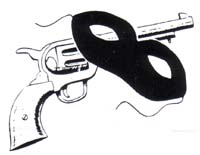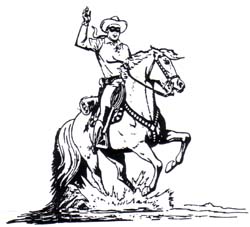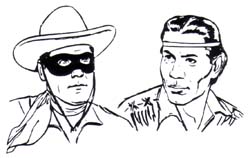|

This story was published in Radio Recall, the journal of the Metropolitan Washington Old-Time Radio Club, published six times per year.
Click here to return to the index of selected articles.
|
|
NOT YOUR OLD MAN'S LONE RANGER
by Mark Bush, © 2003
(From Radio Recall, October 2003)
 In February 2003, I waited with some trepidation for the WB Channel to debut the most recent entry into the Lone Ranger derby. I did not expect much. The WB channel seldom delivers anything I want to see. In a perverse sort of way, I was not disappointed, since there appeared to be far less than met my eyes. The film was a one-hour effort crammed into two hours, the commercials being, on occasion, as entertaining as the movie. In February 2003, I waited with some trepidation for the WB Channel to debut the most recent entry into the Lone Ranger derby. I did not expect much. The WB channel seldom delivers anything I want to see. In a perverse sort of way, I was not disappointed, since there appeared to be far less than met my eyes. The film was a one-hour effort crammed into two hours, the commercials being, on occasion, as entertaining as the movie.
The story changed some crucial things: the last name of the character who would become The Lone Ranger; Tonto's tribal allegiance (Apache, not Potowamie); and introduced a love interest, in the form of Tonto's sister, whom the newly renamed Luke Hartman saved from being manhandled by some white men. Completely lacking, at first, was Tonto's open-minded acceptance of the soon-to-be Lone Ranger as a friend.
I also found Tonto's mastery of oriental fighting styles anachronistic. In the same way, the heavy metal music proved completely out of sync with the time setting. Still, while changing the name of everybody else associated with the ambush, the writers did keep that part of the story intact, following the spirit, if not the letter, of the legend. Luke/Ranger would surely have died if not for Tonto's timely intervention.
From that point on, the divergence is jarring. Luke returns to his dead brother's family and helps in the general mercantile business. He puts on the mask at night, ala Zorro, The Batman, The Shadow and dozens of other pulp, comic book and movie/radio/TV crime fighters. Zorro was, in fact, some of the inspiration behind Trendle's concept of the character, if you can call "I wanna western" a concept.
On radio, television, and the two 1950s movies, the Ranger wore the mask all day, every day, save those times when he was in disguise. True, the two Republic serials presented an unmasked Ranger, at least part of the time. Somehow, though, this changes the story for me. I sense the reason is that it is nearly impossible to get an actor who wants to hide his face behind even a Domino mask for an entire episode.
Perhaps if the story were more character-driven than ego-driven, it would have been more, to use the Warren commission's verbiage, compelling. My first reaction to the story was "Why even call it 'The Lone Ranger'?" The answer came soon enough. The idea was to lure as many people to the telecast to make money. Old-time purists would watch it at least once. If they make it a continuing series, young people might watch it because they found something interesting in the pilot.
To be sure, some things about the concept were positive. I liked the drawings the shaman placed on the inside of the mask. The shaman considered the symbols would bring safety and good karma (whatever that means). The secret signs added another positive, pro-Indian item to the Lone Ranger canon. It was a nice touch and might even be a plot device the writers can use (which sign will invoke the spirit to help solve the Ranger' s problem this week?).
This Ranger also wears one of the coolest shirts in the whole history of the character. My recollection is that Brace Beemer, wore a black shirt (though I was five years old when I saw him). Not a shiny leather or sateen as the most recent one had, but a black one nevertheless.
I also liked Tonto's more forceful personality. Activists roundly condemn earlier versions of Tonto as some sort of Uncle Tom. My reaction was always the opposite. Tonto was not some underling; he was a full partner in the firm. When Tonto said, "Riders headed east toward Durango, Kemosabee," you never heard the Ranger say "Are you sure?" Of course not! The Ranger trusted Tonto's judgment and skills. You can bet money that they rode towards Durango. Each had risked his life for the other many times over.
I read some letters on the Internet from people who gushed over the masterful story, the Olivier-like acting and the "cool" music. I disagree with most of their opinions, but I have a lot of time invested in the radio and television versions. Quite frankly, I appear to be completely out of touch with what young people consider entertaining. I thought Chad Murray (Luke/Ranger) looked too young to be believable in the role. Originally, young Reid, the true name of the Lone Ranger, had been born and reared in the West.
 The often-maligned 1981 film at least had young John Reid living in the West where he learned to ride, fight, and even shoot. The radio and TV versions had him enlisted in the Texas Rangers where he gained experience in riding, tracking, and long hours in the saddle. Clayton Moore, John Hart, and Brace Beemer were imposing figures. Chad Murray's version does not yet look like a young man who has endured much rugged living. Murray's voice still lacks the needed maturity to bring the commanding presence others have given the role. Luke/Ranger even pulls the Harry High-School ploy of pretending he cannot remember the name of Tonto's sister (Alope). The often-maligned 1981 film at least had young John Reid living in the West where he learned to ride, fight, and even shoot. The radio and TV versions had him enlisted in the Texas Rangers where he gained experience in riding, tracking, and long hours in the saddle. Clayton Moore, John Hart, and Brace Beemer were imposing figures. Chad Murray's version does not yet look like a young man who has endured much rugged living. Murray's voice still lacks the needed maturity to bring the commanding presence others have given the role. Luke/Ranger even pulls the Harry High-School ploy of pretending he cannot remember the name of Tonto's sister (Alope).
Over the years, the Ranger character has been licensed to promote Amoco gasoline, Dodge cars, Gino's Pizza Rolls, and the Scout four-wheel drive vehicle. If this was the pilot episode for a new series, it may be first step toward some new rash of advertisements.
The owners of the Lone Ranger franchise do not seem to have followed through with some attempts to keep the traditional Ranger before the public. The Western Channel no longer airs the re-runs. Nor are they available on any of the local channels.
A really great web site has gone missing. This mini-recap of the origin story used a rotoscoped version of the first television episode to outline the grim beginning of this western legend. However, the copyright owners have not missed the opportunity to jump into the DVD market. A series of discs promising "Lost Episodes" has some interesting items. The feature version of the first serial, re-titled "Hi Yo Silver: takes about an hour to watch and is good viewing.
Other items of interest are the original opening of the TV version, and the waving wheat at the middle commercial. These were not available on the Westerns Channel cable casts. The series of discs also includes the "saving stamps" promo. I had never seen this film before I received these discs as a Christmas gift. Many of the half-hour television episodes are available on disc. You can also purchase both the Clayton Moore/Jay Silverheels motion pictures in DVD format.
Maybe it is a sign that people no longer remember, or perhaps are too young to have ever had, the interest in the character many radio and early television fans did. At least twice over the last eighteen months, one of the announcers on WGMS whimsically asked if anyone really still thinks of a masked man on a white horse when they hear Gioacchino Rossini's finale from the William Tell overture. My answer was immediate and annoyed. "You bet I do, bub, and more people know of the Lone Ranger that they do of the smart-mouthed announcer on WGMS."
 In fairness, the early morning man, James Bartel, invited us all to listen to a commercial-free, yucca-free, bullet-free version one morning in the winter of 2002-2003. So, somewhere out there fans of the original concept can find comfort and still remember when a "fiery horse" fearlessly carried a "champion of justice." The WB network, wise-guy announcers, and Tonto's sister aside, "The Lone Ranger" still "rides again." In fairness, the early morning man, James Bartel, invited us all to listen to a commercial-free, yucca-free, bullet-free version one morning in the winter of 2002-2003. So, somewhere out there fans of the original concept can find comfort and still remember when a "fiery horse" fearlessly carried a "champion of justice." The WB network, wise-guy announcers, and Tonto's sister aside, "The Lone Ranger" still "rides again."
Mark Bush is a charter member of MWOTRC, as is his wife, Marsha, and between them, they have served in every officer rank except President. Mark is not only a sound-effects specialist, he is also an authority on The Lone Ranger, Captain Marvel, and since he named his dog "Zorro," you may guess a third fictional character Mark knows well.
|